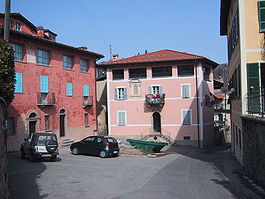Carona, Switzerland
| Carona | ||
|---|---|---|
| Former municipality of Switzerland | ||
 |
||
|
||
| Coordinates: 45°57′N 8°56′E / 45.950°N 8.933°ECoordinates: 45°57′N 8°56′E / 45.950°N 8.933°E | ||
| Country | Switzerland | |
| Canton | Ticino | |
| District | Lugano | |
| Area | ||
| • Total | 4.75 km2 (1.83 sq mi) | |
| Elevation | 597 m (1,959 ft) | |
| Population (Dec 2011) | ||
| • Total | 827 | |
| • Density | 170/km2 (450/sq mi) | |
| Postal code | 6914 | |
| SFOS number | 5170 | |
| Surrounded by | Lugano, Melide, Morcote, Vico Morcote | |
| Website | SFSO statistics |
|
Carona is a former municipality in the district of Lugano in the canton of Ticino in Switzerland. On 14 April 2013 the former municipalities of Bogno, Cadro, Carona, Certara, Cimadera, Valcolla and Sonvico merged into the municipality of Lugano.
Carona is first mentioned in 926 as Calauna. The hamlet of Ciona was first mentioned in 1213.
During the Middle Ages the village of Carona and the hamlet of Ciona formed a Kastlanei of the Bishop of Como. During the Middle Ages the Church of Santa Maria was built in the hamlet of Torello. After 1349, the church was supported by a community of Augustinians Canons from the nearby monastery (built in 1217 by Guglielmo Della Torre). For the village's loyalty to the Visconti and Guelph families, it received its own coat of arms. According to Swiss Confederation law, it enjoyed a special status (terra separata) which included exemption from certain laws and taxes. The old, medieval statutes were renewed in 1470.
The Carona romanesque village church of San Giorgio was first mentioned in 1425. Two years later it was raised to become a parish church. The church of S. Marta was built in the 14th century, and was formerly known as the Church of SS Pietro e Paolo. The Baroque pilgrimage church of Madonna d'Ongero was built in 1624, to the west of the village in the forest. The church of S. Maria delle Grazie was built in Ciona. The last two churches as well as the homes of the village from the 17th and 18th Centuries represent the growing wealth of the village, through emigration of artists from Carona. The Carona artist families, including the Aprile, Casella, Scala and Solari families, were active throughout Europe during the 15th-18th centuries.
...
Wikipedia




